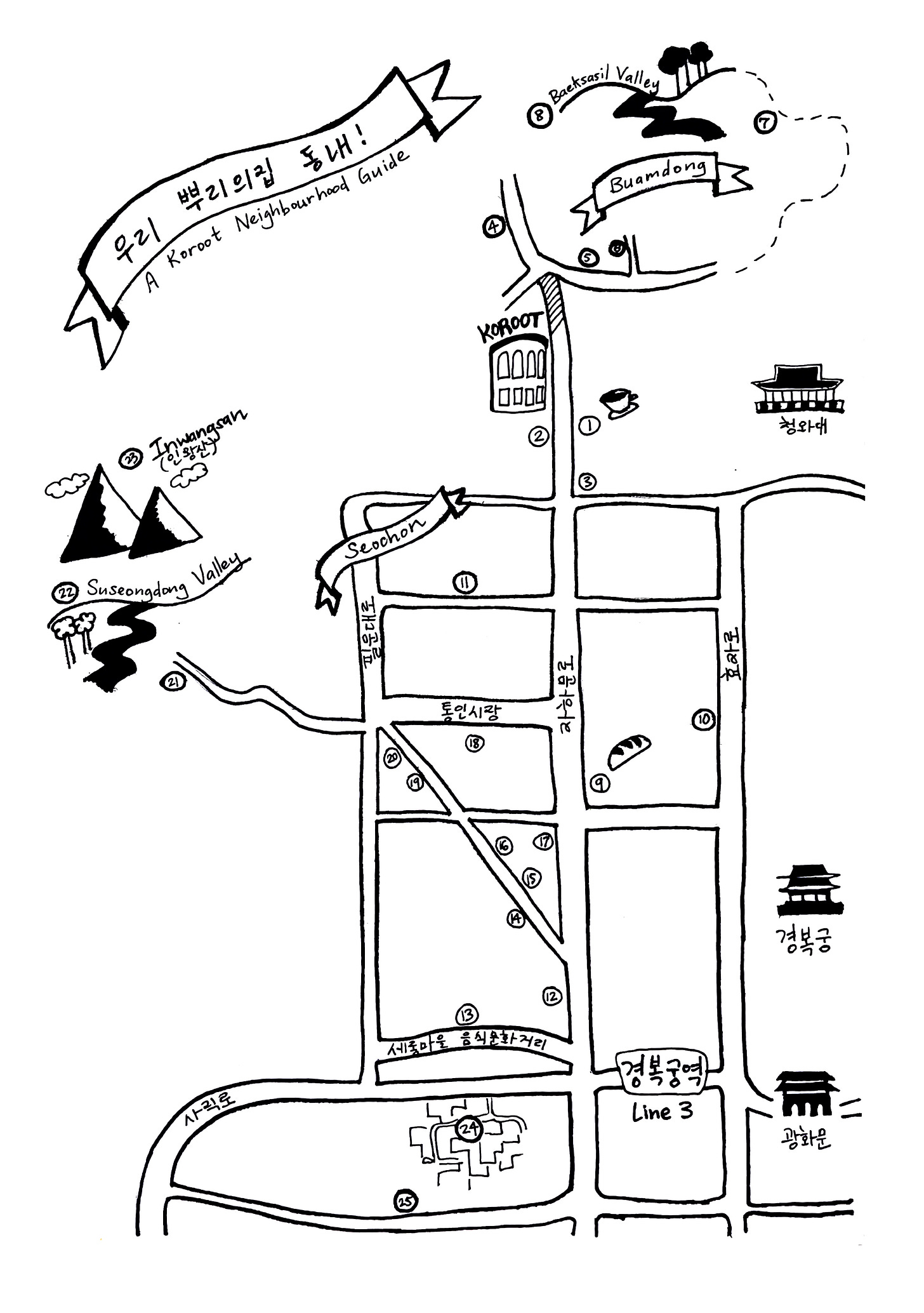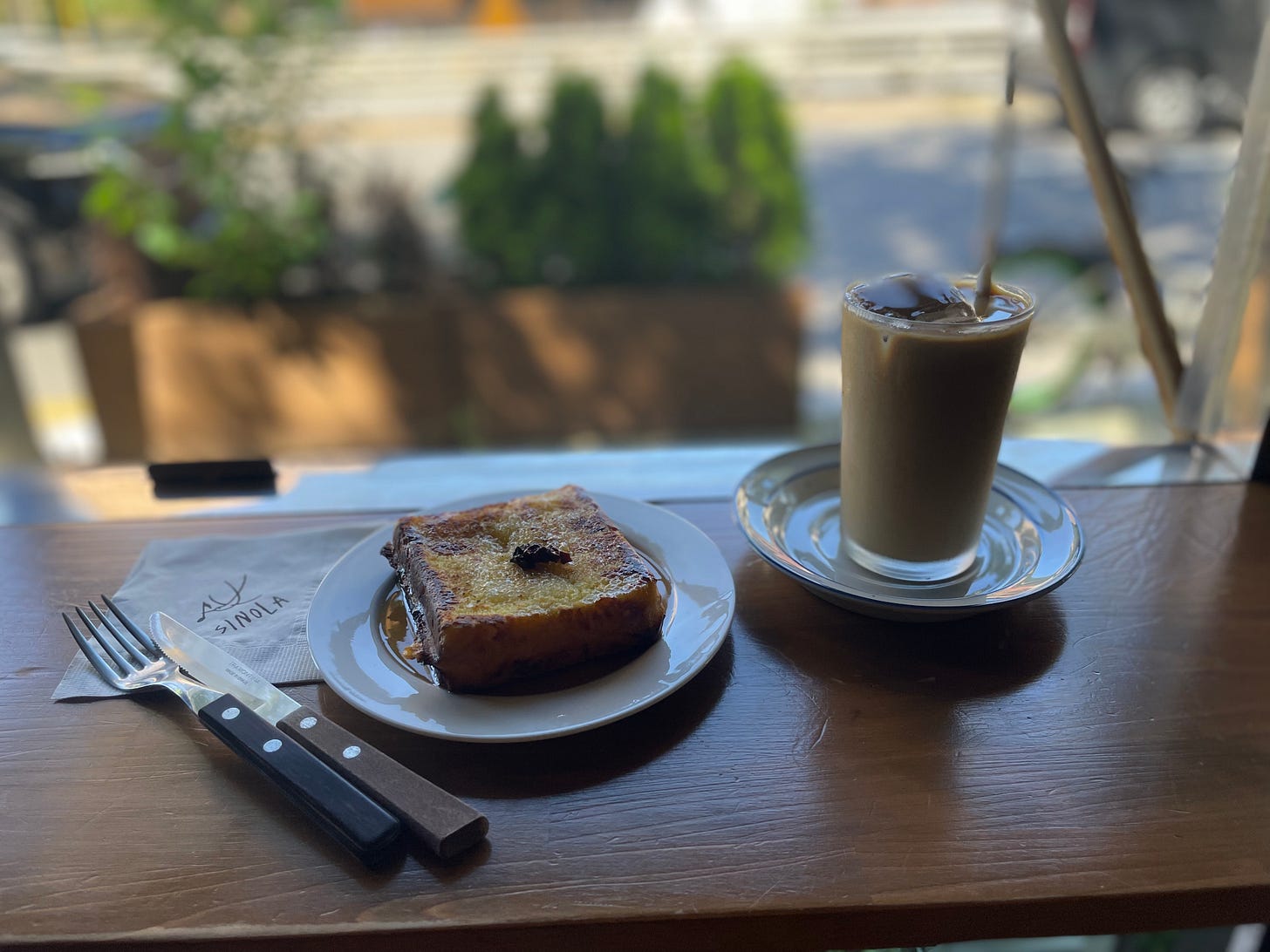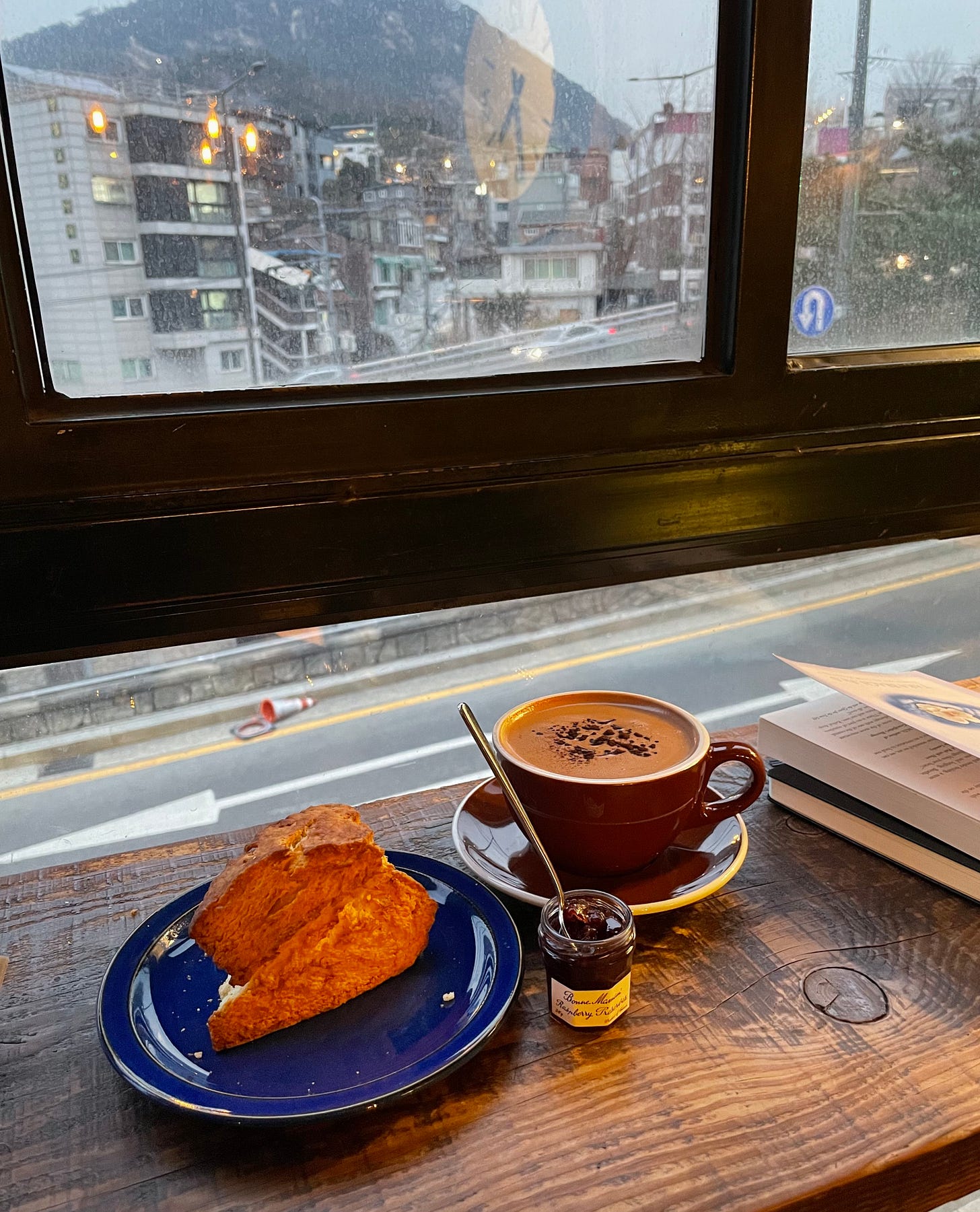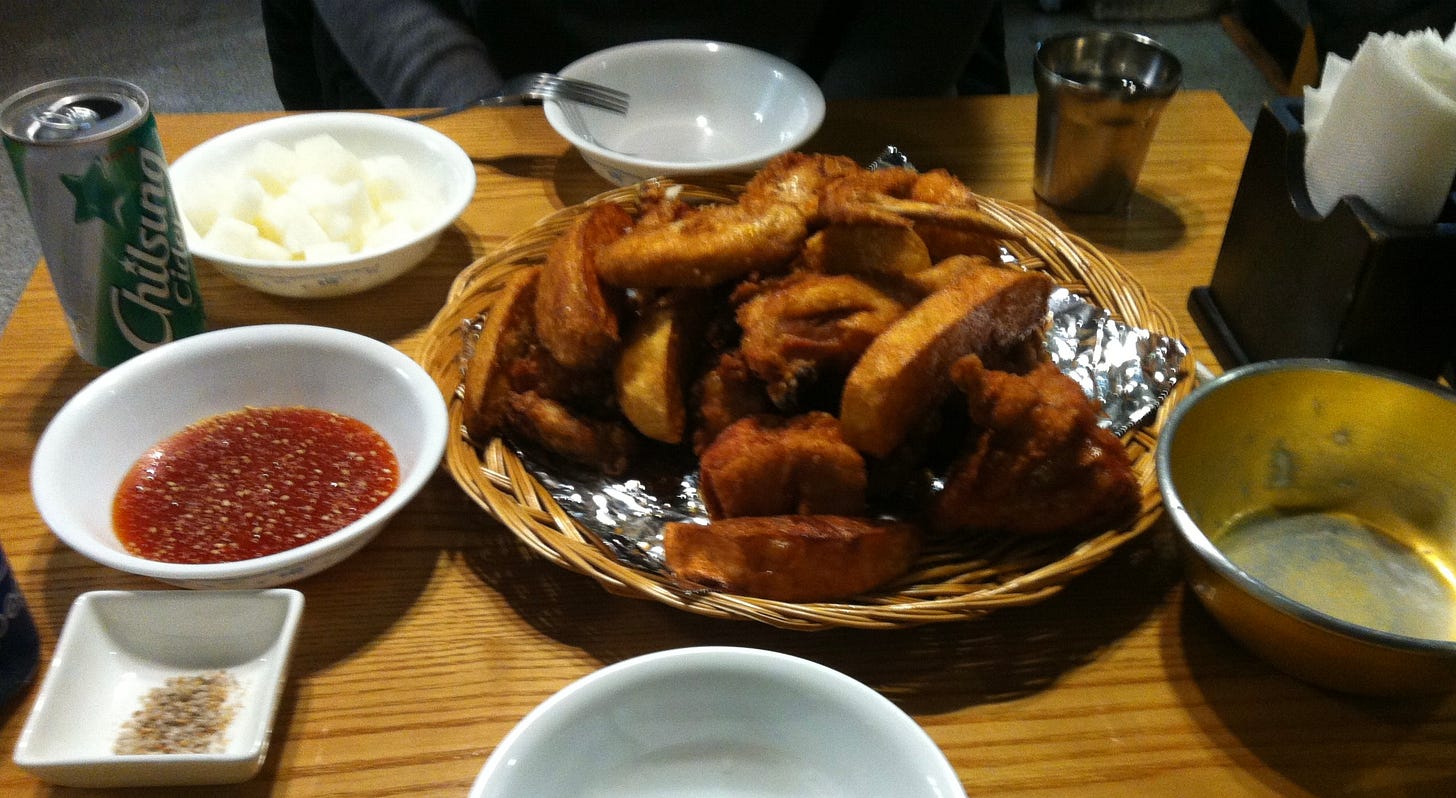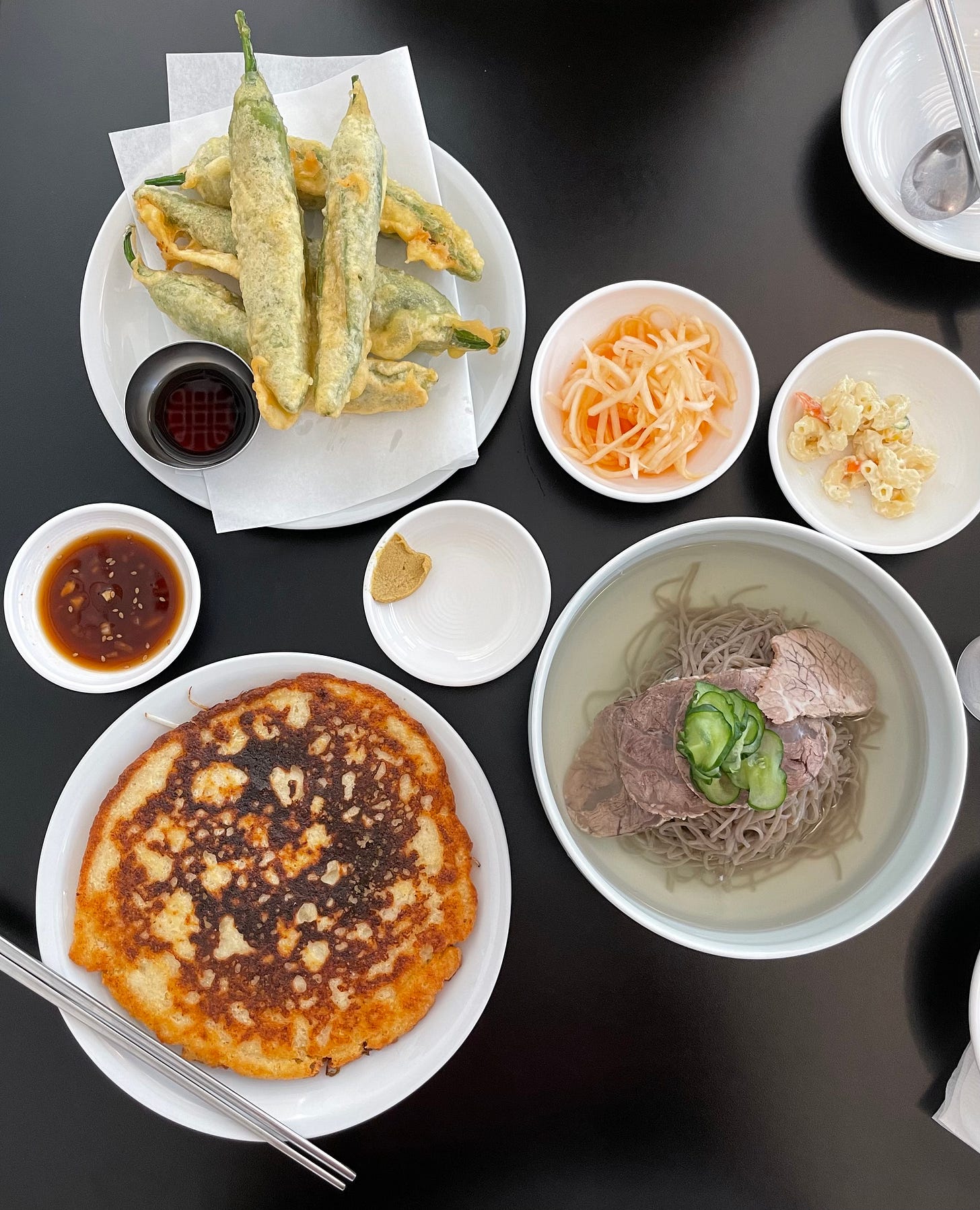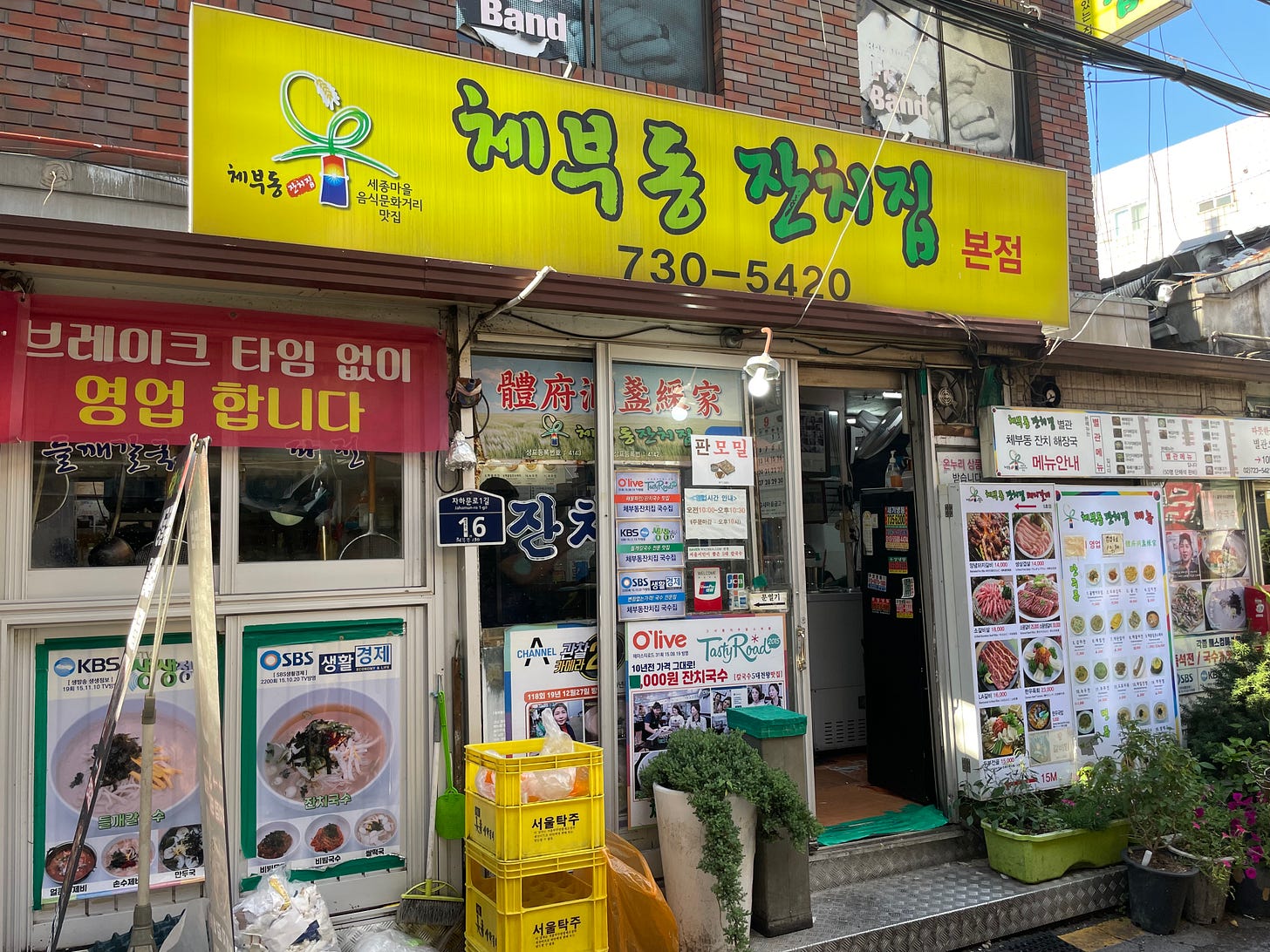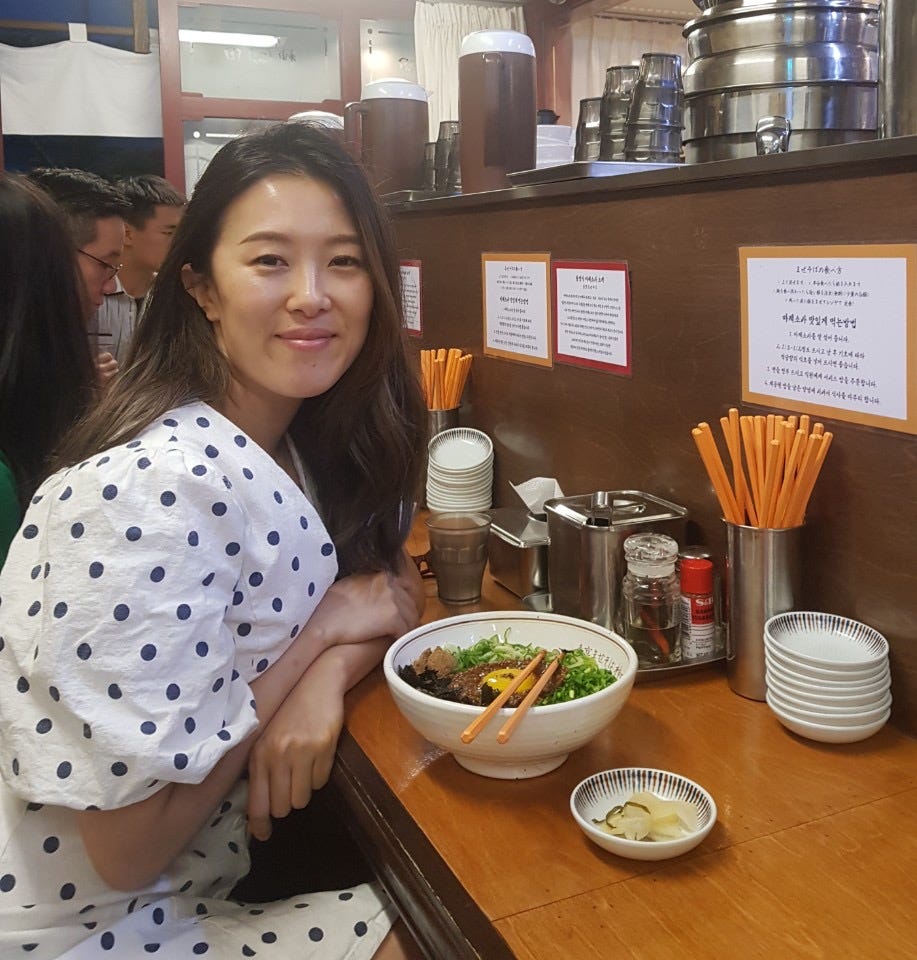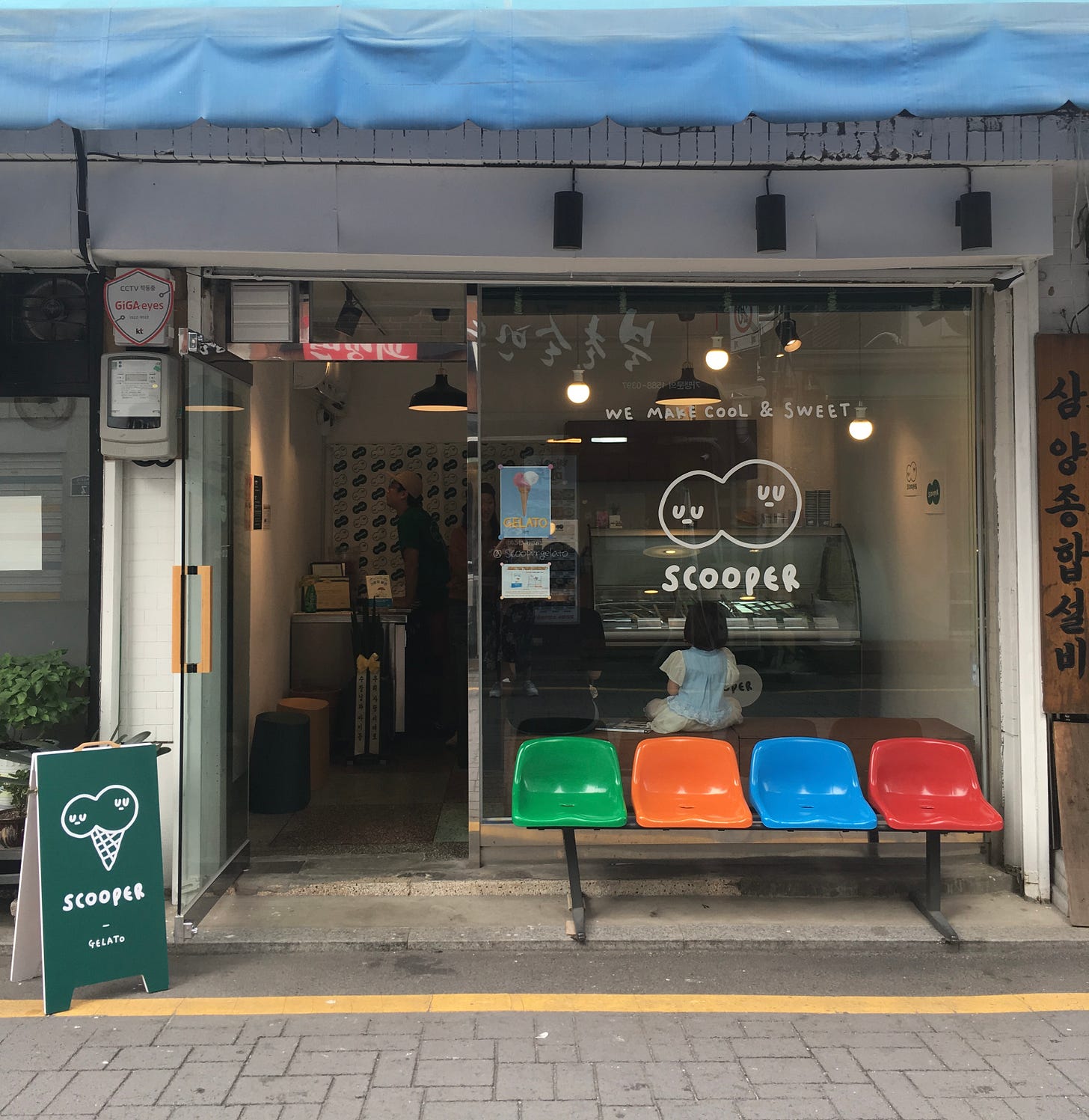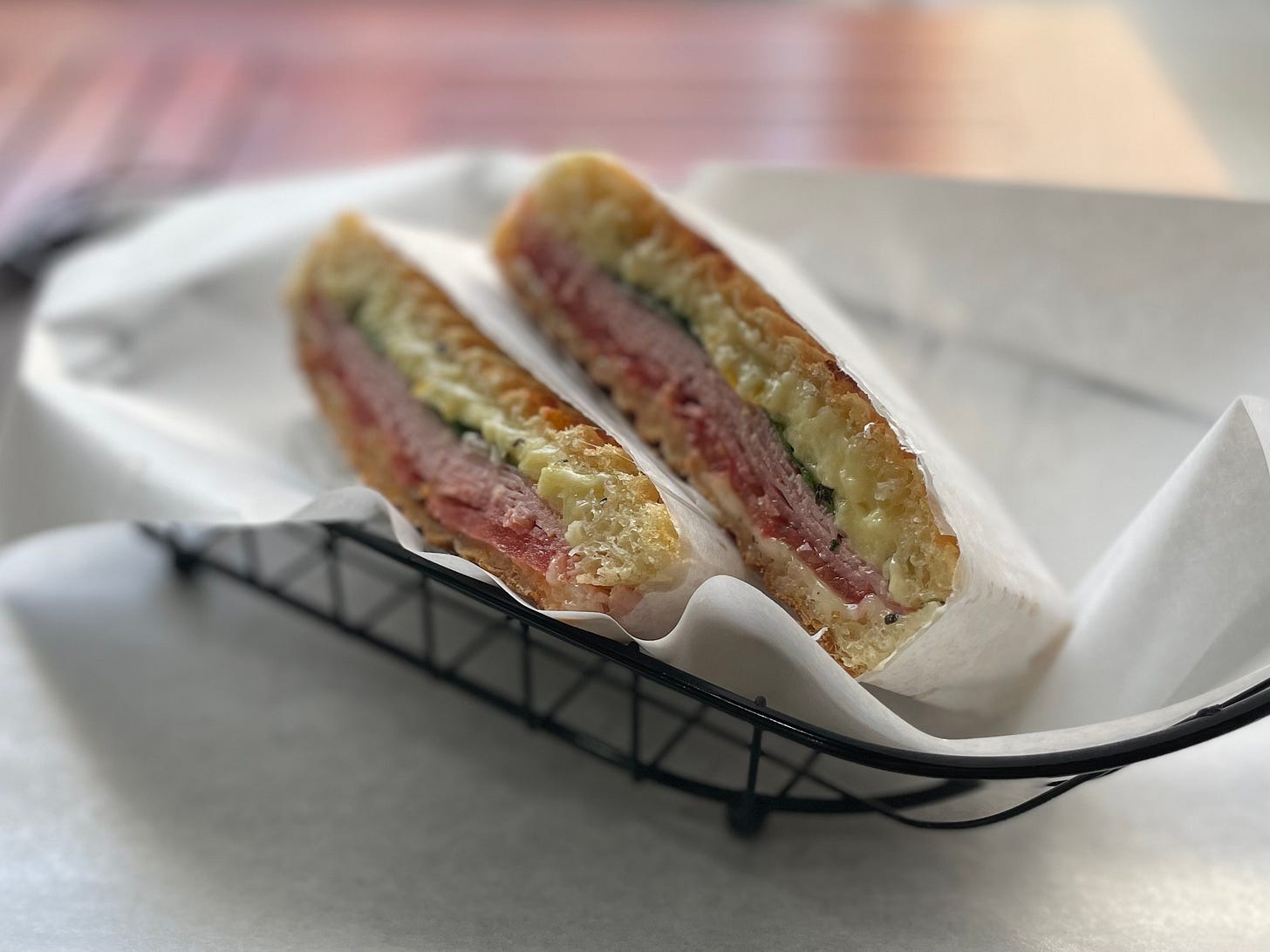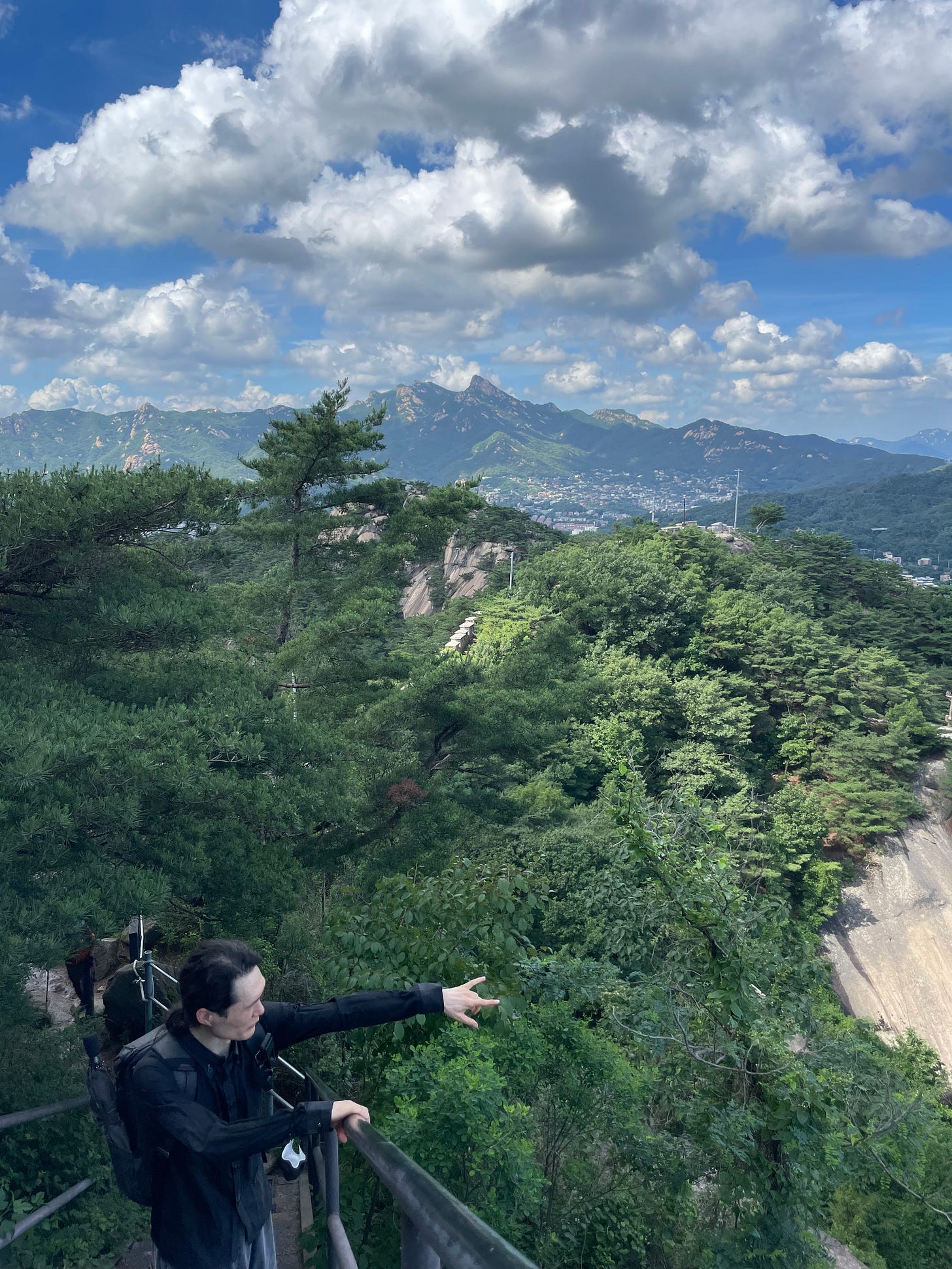KoRoot, a guesthouse for adoptees returning to Korea, will close next summer after 20 years of operation. This large, stone-built double storey house in the heart of Jongno-gu, was my home away from home when I first started visiting Korea from the early 2010s, and later, where I lived for 6 months in 2017, in a small women’s dormitory where I almost went crazy.
To celebrate the last year of KoRoot, here is a little guide to the surrounding area, featuring cafes, restaurants, bars, and green spaces in Seochon and Buamdong—an invitation to explore what I think is the most beautiful neighbourhood in Seoul (and by no means an exhaustive list). There is also a lot of gorgeousness on the east side of Gyeongbokgung Palace too, of course, but I had to draw the line somewhere (terrible pun, sorry).
My favourite cafes and restaurants—often of the small, cozy, quaint variety—are the places I go to for comfort, particularly in lieu of the people and places I’d turn to in Australia. So for my fellow returning adoptees and other Koreans of the diaspora, I’m hoping you find this useful, and I hope that, by discovering something delightful down an unknown street, or through a warm encounter with a friendly sajangnim, you find some small sense of comfort, connection—perhaps even belonging—in Korea.
[Super close to KoRoot]
카페 시노라 (Cafe Sinola)
서울 종로구 자하문로 116
Mon-Sat 10-6, may close early Sat
Cafe Sinola, almost directly opposite KoRoot, might be my new favourite cafe. If I lived closer, I’d be a regular. It’s quiet and intimate—perfect for a little pondering, reading, or journaling (which, I dare say, you may have some need for merely by virtue of being an adoptee in the motherland), with its light-filled wood-panelled interior, and jazz and classical on vinyl. The sajangnim (proprietor) seems effortlessly cool too, lithely preparing drip coffee and french toast (simple but good, using brioche from the nearby Petit Tong bakery) from the tiny kitchenette, sometimes pausing to have a cigarette by the tree outside the cafe, or to change the record on the turntable. (I had actually forgotten what the brief silence between record changes felt like in our endless autoplay age. It’s lovely.) There are signs of thoughtful attention to detail, too, behind the laissez-faire, such as oversized ice cubes which stack neatly in the tall iced coffee glass, flame-charred sugar on the french toast, and a plug-in mosquito repellent in the bathroom. Go on a weekday before noon to avoid the insta-queues, take the window seat looking out onto Jahamunro, and remember that life is good.
중국 (Chinese)
서울 종로구 자하문로 33길 2
Mon-Sat 10-1 (*early* lunch only)
https://naver.me/GIq877K8An unassuming little Korean-Chinese noodle restaurant where introverts (not me) and solo diners (often me), faced with the age-old dilemma of choosing between jajangmyeon and jjamppong, must rue their fate because the best decision is to share one of each with a side of fried dumplings and/or tangsuyuk (crispy sweet and sour pork). Beware: they close when they run out of ingredients and Koreans tend to eat lunch quite early.
블루베리 (Blueberry)
서울 종로구 자하문로 94
(lunch only)
https://naver.me/F2vLFq7LTiny, humble restaurant serving warm noodle soups in a light, delicate broth, and spicy cold noodles (pictured) with a sweet-but-not-too-sweet housemade bibim sauce, both using housemade wheat noodles, and bibimbap.
But no bluberries.[Buamdong]
럼버잭 (Lumberjack)
서울 종로구 창의문로 151 1층
Tues-Sun 12-12
https://naver.me/xivSspSKI have been visiting this cosy Buamdong cafe for ten years now and I’m thrilled that they have survived thus far in Seoul’s cutthroat cafe scene. Part of my attachment is surely nostalgia, but I love the view of Bugaksan ahead and Bukhansan to the left from the second floor window seats, and the dark hot chocolate in winter and the iced white “hot chocolate” (which is…basically chocolate milk with some ice in it? Gonna let that one go) in summer.
부빙 (Boobing)
서울 종로구 창의문로 136 부빙
Tues-Sun 1-7
https://naver.me/GbEcggBi
@ice_boobing
A terribly cute little bingsu cafe with unique, seasonal sweet and savoury toppings, such as grape with lemon cream, yellow melon (참외), corn, and potato puree. Expect a wait in summer.계열사 (Gyeyeolsa)
서울 종로구 백석동길 7
Tues-Sun 12-10:30
https://naver.me/IMQpzXucKorean fried chicken, as we all know, has become a major international export, with an ever-evolving range of toppings and glazes such as bburinkle, and onion snow, and snow cheese, and melting snow cheese, and spicy red garlic shrimp golden egg melting snow cheese. But Gyeyeolsa, an OG chicken establishment that I first stumbled upon in the winter of 2015 (as this blurry iPhone 3 photo attests) only has one type of chicken—thinly-battered and well-seasoned, served with thick-cut potato wedges, and once named one of Seoul’s top three 3 fried chickens. They have a few other dishes, including spicy sea snails with noodles (which I was too nervous to order back in 2015 but now regret), and Jeju Beer.
산모퉁이 (Sanmotoonge)
서울 종로구 백석동길 153
everyday 11-7
https://naver.me/5fnjEUN3
A bit of a hike from the main Buamdong drag, the coffee is even more expensive than your standard Korean cafe coffee, but the expansive view of the mountains from the back patio is lovely. The kind of patio that you wish you actually had at your house, so you could wander out in the morning for a leisurely breakfast wearing a stylish bath robe, like Gillian Anderson’s character in Sex Education. Also, this was the filming location of Choi Han-Sung’s house in the 2007 Coffee Prince drama—one of the classics of the genre, if you haven’t seen it—featuring Gong Yoo in his breakout role as Han Kyul, who was basically the perfect male leading character in a K-drama of all time.백사실계곡 (Baeksasil Valley)
entrance 1 past Sanmotoonge Cafe: https://naver.me/Fbu5JhPK
entrance 2 from Segeomjeong Elementary School: https://naver.me/FGoLe4uxSeoul has an energy all its own—part historically traumatised country still in balli, balli survival mode plus the never-ending hamster wheel of the capitalist patriarchy, yes—but wonderfully dynamic. Dynamic, but hectic. And when the hectic-ness becomes too much, you could visit the Baeksasil Valley, a nature preserve in the Bugaksan forest, which still seems relatively “hidden” and “secret” despite being covered by a couple of Seoul’s middle-aged white male journalists (thank you guys) a few years ago.
Directions are not my strong point, but armed with the map above (with the valley entrances loosely marked), plus Naver or Kakao Maps and a sense of direction beyond mine, you should be fine. Basically, continue past the Sanmotoonge Cafe and a few Buddhist temples to your left, until you see an inconspicuous little signpost leading to narrow dirt trail (entrance 1). A short while later, the path opens to a small tree-covered valley with a clear, flowing stream.
[Seochon]쁘띠통 (Petit Tong) (Swiss bakery and deli)
서울 종로구 자하문로 40-1
everyday 9:30-8:30
https://naver.me/GEAIjWP6
@petit_tong_bakeryThere will come a time when you really miss Western style bread in Korea, when you cannot face another slice of soft, fluffy white stuff that you can scrunch into a tiny ball—no, you want something chunky, something with heft, with a crust you can really sink your teeth into. And when this time comes, you could go to a Korean outpost of Tartine and pay $25 for a country loaf inferior to the original Tartine, or you could go to Petit Tong—a modest little Swiss bakery with a variety of European style breads on offer, as well as other hard-to-find things in Seoul, including raclette and gruyère cheese, housemade hummus and tapenade, and a few deli meats. Both your summer picnic needs and your winter fondue party needs sorted.
온지음 (Onjium)
서울 종로구 효자로 49 4층
Tues-Fri 12-3; 6-9
https://naver.me/GcjWxF02
@onjium_restaurant
Because it’s usually outside my budget, I’ve had few fine dining experiences in my lifetime, but it is definitely an experience, and if you’d like to try it in Seoul, consider Onjium led by chef Cho Eun-hee, one of three female chefs with a Michelin star in Korea. Simple, delicately seasoned dishes influenced by both Korean royal cuisine and Korean Buddhist temple cuisine, served with high-end Korean spirits and rice wines, in a super modern, elegant space overlooking Gyeongbokgung Palace.안덕 (Andeok)
서울 종로구 자하문로17길 18 1층
Wed-Sun 12-2:30 (last lunch orders at 2) and 6-9
https://naver.me/FGo1484gSummer is objectively the worst season in Korea—humid, wet, increasingly unpredictable due to our
fuckedrapidly warming planet, and beset by an abundance of mosquitoes boasting an internationally competitive strength and tenacity. I completely understand why some residents leave for the season. However, if you’re stuck here, as I was this year, what can you do but try to make friends with summer?
I haven’t fully figured out how, but as a start, I lean into Korea’s seasonal offerings, such as cold noodles, bingsu, watermelon juice, fat shine muscat grapes, andchamwemelons(could take them or leave them, personally). Go a step further and see how many different types of cold noodles you can try: mul naengmyeon, bibim naengmyeon, jjolmyeon, makguksu, kongguksu, bibim guksu, etc.
TLDR; summer sucks, eat cold noodles.
Andeok is famous for their Pyongyang-style naeng-guksu (cold buckwheat noodle soup with beef, summer only) and mandu guk (dumpling soup), both served in a clear, light broth (it might be slightly bland to a western palate; you would describe the taste as 담백하다 in Korean). I would order one of each plus the gochu twigim (deep-fried pork-stuffed green chillies) pictured. Expect to wait around 20-30 minutes for a table.토속촌 (Tosokchon)
서울 종로구 자하문로5길 5
everyday 10-9:30 (last order at 9)
https://naver.me/5iz06z1j
I wasn’t planning to include this samgyetang (a thick, luxurious soup containing a whole baby chicken, rice, and ginseng) restaurant here because it’s a bit of a tourist trap (very off brand!) and the prices have risen steadily with its popularity, but it’s also a local institution, as my older and wiser Danish adoptee friend reminded me. And when older and wiser adoptee friends give you advice, you are best advised to listen. No one else really knows or understands the weird, wonderful, mostly weird ride of being a Korean adoptee returning to the motherland. But these sage elders have already been through it—their lives have been temporarily suspended, possibly derailed, like a train lifted up by an enormous crane and dropped down again on a completely different track, or no track at all—and so, though everyone’s journey is different, your overall arc is predictable to them, like the plot points of recent Marvel movies.
ANYWAY before I ride even further off this track, my friend is right: the samgyetang (as well as the cabbage and radish kimchis) are pretty good. Be prepared to line up, order a samgyetang each and perhaps a haemul pajeon to share, and as you clink your porcelain cups of insamju (ginseng liquor) together, you can thank the universe that at least you’re not in this alone.체부동잔치집 (Chebudong Janchi)
서울 종로구 자하문로1길 16
(on 세종마을음식문화거리 “Sejong Village Food Culture Street”)
everyday 11-10.30
https://naver.me/Gi9s0EgVThis is one of those restaurants that seems to have everything—all manner of noodles and jeon, that is, with their usual accompanying suspects dubu-kimchi (tofu and kimchi), dotorimuk (acorn jelly), gyeran-mari (rolled omelette), and mandu (dumplings) too—and therefore, it would be only natural to come here and order a variety of things to share. However, they are known for their deulkkae-kalgugksu (perilla seed noodle soup), once named one of Seoul’s top 5 best kalguksus, and I know this because of their Naver maps info, but also from my first visit—a rare and tragic case of family-style backfiring—when a fellow diner who very clearly wanted to order the deulkkae-kalgugksu, and only the deulkkae-kalgugksu, was forced to share her dish with everyone else, smiling graciously, and pick at other dishes she never wanted. She probably knew that the deulkkae-kalgugksu was famous, she was probably a Virgo sun/rising and a millennial, she might have instagrammed her noodles if only others hadn’t been so quick to eat them all.
If you find yourself in a similar situation, the simple solution is to order two bowls: one can be oori (our) kalguksu, and the other one is all yours: this is what you want; no, you will not be sharing; and you will not feel guilty about not sharing (um, it’s called boundaries, look it up on TikTok or something).칸다소바 (Kanda Soba, Gyeonbokgung branch)
서울 종로구 자하문로7길 5
everyday 11:30-3 and 5-9
https://naver.me/FiLE0wcG
Kanda Soba only has two things on the menu and they do them very well: maze soba (“mixed noodles”) and abura soba (“oil noodles”). They are both Japanese “soupless ramen” dishes—chewy ramen noodles (no actual soba here) with various toppings plus chilli oil and/or vinegar added to taste. They are among the most delicious things I have ever eaten. Like an explosion of umami in your mouth. I don’t know exactly what makes them so delicious, maybe it’s MSG (I hope so).
The maze soba (for a brief history, see here) is topped with spicy minced pork, roasted seaweed, green onions, chives, and a magical tasty powder. The aruba soba is topped with a deeply flavoured oil made from boiled beef bones, green onions, and copious chives. Both come with an egg yolk and you can also add char siu and a tamago egg, but no need to gild the lily. I think this would be a cute date place—you can sit side by side and follow the recommended eating instructions together (don’t forget to ask for rice to mop up the leftover deliciousness after you finish your noodles)—except that you might get little green things stuck between your teeth, and you have to wait.
Ah yes, the wait. At least an hour I’d say, but worth it. (And what kind of hipster food wanker are you if you’re not willing to line up for food, anyway?)스쿠퍼젤라또 (Scooper Gelato)
서울 종로구 자하문로7길 10
Wed-Sun 12-9
https://naver.me/GFpe1xtH
@scoopergelatoGelato stores are popping up everywhere in Seoul now, but when Scooper first opened three years ago, it was hard to come by. It’s still one of the best in the city, with a rotating mix of Western and Korean flavours, both classic and slightly experimental, including mint chocolate chip, basil milk, pistachio, and Lotus (the Biscoff speculoos cookie), as well as Jeju matcha, mugwort rice cake, and a seasonal watermelon, peach, and Milkis sorbet. The owner is super friendly and trained in gelato-making in Bologna (where I had the most delicious gelato of my whole damn life) and Florence.
Bar Cham
서울 종로구 자하문로7길 34
everyday except Tues 6pm-1am
https://naver.me/FuVEzpfq
@bar.chamMy favourite bar in Seoul’s young but burgeoning craft cocktail scene, Cham no longer needs any introduction, having steadily climbed the list of Asia’s 50 Best Bars, three years running. (By the way, if you look at this list you will notice that another bar in Seoul, not far from Cham actually, is ranked much higher. All I can say is, feel free to go there instead, if you like larger, bling-ier, more expensive hotel bars with less personalised service.)
Cham’s original creations use local Korean spirits, as well as the regular western ones, in a very accessible way (to be honest, my own Westernised palate is still getting acquainted with their wild, funky notes). I love the converted hanok space as much as the drinks too: understated yet warm, with a large oak-wood bar and the scent of torched pine often lingering in the air from one of their signature cocktails, the Hamyang—my personal favourite (from the old menu; the Namyangju is my absolute favourite from the 2022 menu).
The service is sophisticated but always down-to-earth, patiently accommodating English-speaking guests since 2018. Sometimes I like to remind people that I used to go there back in the day, before they got famous, but that is very uncool, so I have stopped saying that. Unfortunately, they now have a wait to match their popularity (up to 2-3 hours, yikes) but you can also make a reservation for groups of up to 4 between 6 and 7pm on weekdays. Otherwise, leave your details by the front door early and then get dinner at a casual restaurant nearby—the 세종마을음식문화거리 “Sejong Village Food Culture Street” offers lots of options—go for the kind of place where you can quickly wrap things up as soon as your number comes up.
델리노쉬 (Deli Nosh)
서울 종로구 자하문로 35-6 1층
Tues-Sun 10-8
https://naver.me/FRDWZ8j6
@deli_nosh
So I don’t know about you, but personally, comfort is often food, and comfort food is carbs and cheese. And when you move to a foreign country where you can barely speak the language (and where you might be confronted with your adoption on a daily basis), some comfort is in order. Living in Korea has given me a new appreciation for the humble grilled cheese, which is surprisingly difficult to find here. After spending some time in Philadelphia, the owner of Deli Nosh has brought the secrets of the classic Italian American sandwich shop back to Korea, where he makes ham and chicken paninis with fresh housemade focaccia. One bossy note: be patient while waiting for your panini—a proper melt takes time.공기식당 (Gonggi)
서울 종로구 필운대로6길 20-1
Tues-Sun 12-2:30ish and 5:30-7ish (or until sold out)
https://naver.me/x8lituXv
@lonely_table
Tucked in the back alleys near the Tongin Market, this sweet little restaurant with a solo-manned kitchen and cute postcards and a cat calendar on the wall—where it almost feels like you’ve dropped into a friend’s, or a friend of a friend’s house for lunch—is precisely the kind of place that I’m a complete sucker for. They have one or two Indian-ish curries of the day—usually a butter chicken plus a pork or shrimp curry, or a palak paneer, with a couple of rotating side dishes. This is not the place (nor the country, really, much to my disappointment) to expect assertive, strongly-spiced Indian food (except for maybe here); instead, the food is simple and comforting. The perfect cosy lunch for one or two.목권의 서촌가락 (Seochon Garak)
서울 종로구 자하문로7길 59
everyday 12-10
https://naver.me/FuVE6SJaSometimes people ask me how I find restaurants—not to say that I am an expert finder of restaurants!—but when asked, I reply that it is a combination of spending way too much on Naver Maps/Blogs and Instagram, checking into the Restaurant Buzz Seoul Facebook group, and just walking around and following my nose. The last method is my favourite because when the place turns out to be good, it makes me feel like I have some kind of sixth sense, some supernatural instinct for good food—though I know that, in reality, sometimes I just get lucky.
I think I was first lured into this little makgeolli jib by the sweet agi-jagi shopfront which leads to a narrow interior fitted with Korean paper lamps, and a gayageum (traditional stringed instrument) and handwritten menus adorning the walls. Open since 2017, they have a variety of makgeollis (also available by the glass for 2,000 won!) and simple, gently seasoned anju including dotorimuk (acorn jelly with salad in a spicy soy dressing), kamja jeon (small potato pancakes), vegetable mandu in rice flour dumpling skins, gondeure namul bap (wild greens with rice), and seafood kalguksu (noodles in seafood broth). The hospitality is warm and patient, and the owner is always glad to practice some of his English.튀튀쿠키 (Tui Tui Cookie)
서울 종로구 자하문로7길 69-1
Wed-Sun 11-7
https://naver.me/FEJAxShp
@tuituicookieThough I mentioned earlier that comfort food for me is carbs and cheese, it is also baked goods. The alchemy that happens when you take butter, sugar, flour, and eggs, and transform them into something entirely different is pure magic. It reminds me that the world is a wonderful place. Super cheesy, but true!
I’m embarrassed to admit how much time and money I’ve spent hunting for the perfect American-style chocolate chip cookie in Seoul: something large and substantial, with weight, something that pushes the limits of ‘snack’ into ‘small meal’ territory, firm on the outside, soft and slightly chewy on the inside, with large chunks of good quality chocolate—good enough that you’d eat it on its own, un-enrobed by cookie dough, and more of it than you’d think is necessary—all balanced by a little salt. Something like this.
After saying all that, Tui Tui Cookie is not my perfect American-style cookie, being softer and less rich than I’d personally like, but it is a very respectable one, made with care by a Cordon Bleu-trained former hotel pastry chef. According to Instagram, they pre-toast the flour for their signature chocolate chip walnut cookie, although I can’t say that my palate is refined enough to tell. But even my recently migrated friend from San Francisco, aka Home of Most Excellent Breads and Pastries And They Know It, palate and expectations not yet altered by Korean tastes, conceded that Tui Tui’s lemon cheesecake cookie was pretty good.
They have coffee too, so if you drop by, check if the upstairs couches are available—the perfect place to sample a few different cookies with a friend and bond over your newly discovered mutual pastry snobbery.누각 (Nugak)
서울 종로구 옥인6길 5
Mon/Tues/Wed/Fri/Sat 11.30-2 (lunch only)
https://naver.me/GVANG2I9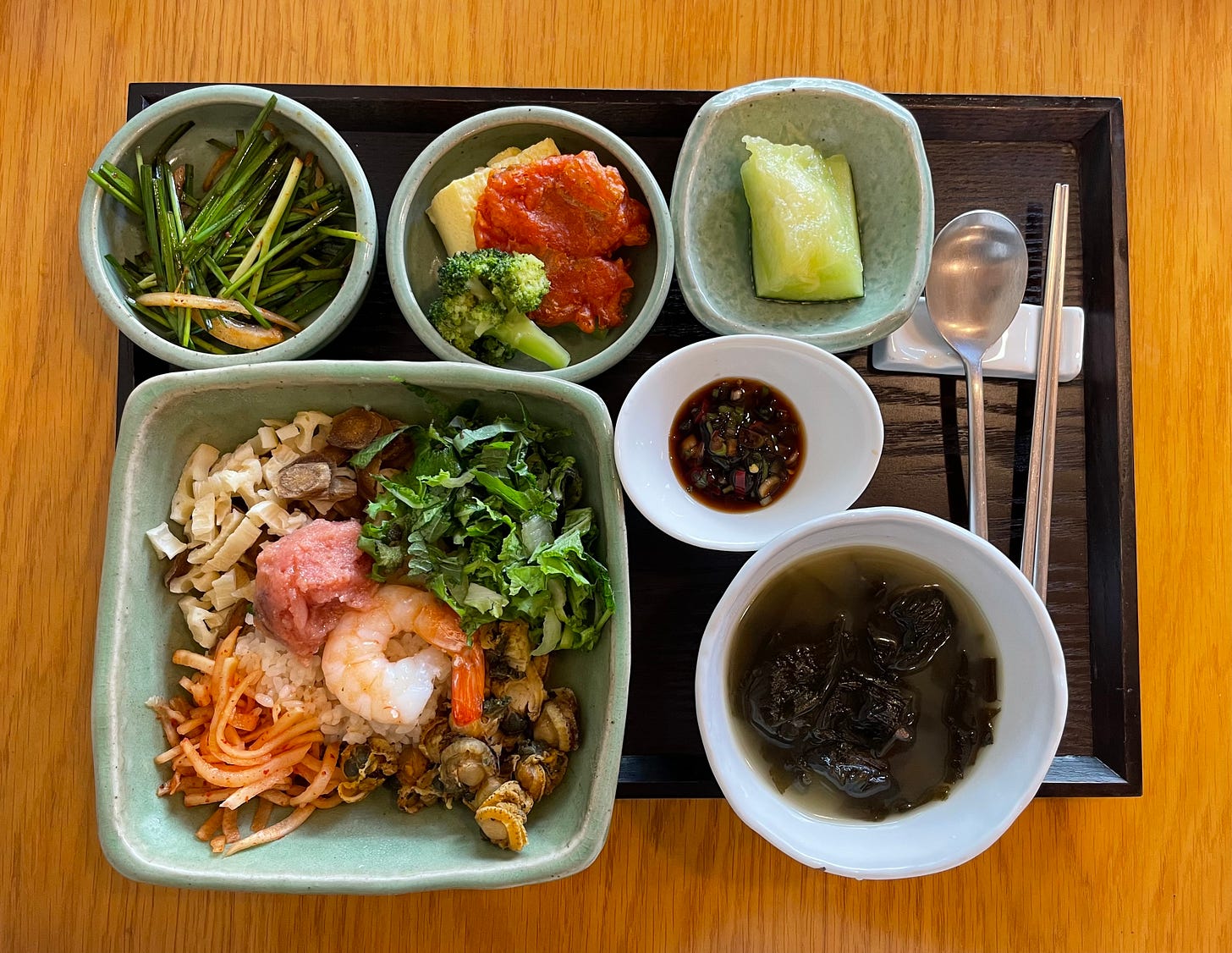
oh the health! seafood with lotus root and burdock rice (kinda like a seafood bibimbap) with miyeok-guk (seaweed soup) The last time I visited the Suseongdong Valley, on a bright, clear day in early fall, I spotted a small unsigned restaurant on the left, just before the entrance of the valley, with an outdoor patio, bustling with laughter. I’d never noticed it in all these years of walking the same path—past Kim’s Boutique where I bought a dress that I’ve worn to death, past the ‘cute store’ with the socks and other small cute things displayed outside, the Jongno branch of Scoff British bakery that I manage to resist 9 times of out 10 (except when they have hot cross buns around Easter, of course), and increasingly bougie cafes and homewares stores.
But Nugak has been there for six years, solely run by one ajumma who makes homestyle Korean food with fresh seafood and vegetables, as well as beef ddeokgalbi (short rib patties) with shiitake mushrooms and a beef shank soup, accompanied by banchan and seasonal fruit. Amazed by her front- and back-of-house multitasking, I asked her if she had previously worked in restaurants, but she said no and seemed slightly confused by the question (or maybe it was my clumsy Korean). Anyway, go and be nourished (and get some fibre in your system if you’ve been eating a diet like mine). There are only five or six tables so bookings are advisable (by phone or in person).수성동계곡 (Suseongdong Valley)
서울 종로구 옥인동 185-3
I usually just pass through the Suseongdong Valley on my way to Inwangsan, but this small but lush green space is worth a stop regardless. There are winding paths, trees that sway gently with the valley breeze, trickling streams running over large boulders, and a little pavilion where one might pause to read a book or eat a gelato or both. It’s all very picturesque, very cottagecore—very pleasing to my Virgo sun aesthetics. And when you cast your gaze upwards, especially on a clear autumn day (autumn being objectively the best season in Korea, or maybe anywhere), there stands Inwang Mountain, tall and majestic, smiling down benevolently.인왕산 (Inwangsan Mountain)
https://naver.me/GmFVErBfPOV: You’re a millennial with a short stay in Seoul, so you want a definitive “Seoul experience”. You want to do this city right and get grammable content while you’re at it! Of course, you must go hiking. Seoul is dotted with mountains, 107 of them, in fact, peaking over horizons and behind apartment complex skylines. But you only have time for one. Which one do you choose?
Inwangsan (인왕산), is a less popular, slightly lesser-known hiking destination, but it checks all the boxes and then some. Leafy, winding paths for a calm-inducing dose of greenery. A rocky final ascent that makes you feel a *tiny* bit like a rock climber. Great views of the city, including Cheongwadae, the President’s former residence—now open to visitors, and neighbouring peaks. A section of the Hanyangdoseong, Seoul’s 600-year-old fortress wall. A stray mountain kitty or two. And you can do the whole thing comfortably, with a little rest/photo opp at the peak, in under two hours.
Inwangsan is Seoul’s perfect short city hike. Case closed!
You have different entry/exit options, but I take the route that my aforementioned older, wiser, avid hiker Danish adoptee friend showed me, starting from the Suseongdong Valley. Follow the path on the right, which basically leads straight through the valley until you hit the Inwangsan road. After you cross the road, there are two sets of steps: stone ones opposite a crosswalk to the right, and rope-covered ones further to the left. I take the rope-covered ones, which basically go straight up the mountain, your exertion rewarded with increasingly scenic views. After you climb the boulder-y bit to the peak, you can descend by following the fortress wall all the way to Changuimun Gate and seek post-hike refreshment in Buamdong.Expensive little alleyway cocktail bars
서울 종로구 사직로12길 16 단독1층Mon-Sat 7pm-3am, Sun 6pm-2am
서울 종로구 사직로12길 17
Mon-Sat 7pm-2am
@tenderbarseoul
서울 종로구 사직로12길 19-17Tues-Sun 7pm-2am
@abysscat
Even after years of living in Seoul, one of my favourite things to do is just wander around unknown neighbourhoods and soak up the ambience. I find the Jongno area especially charming, with its centuries-old hanok buildings and narrow alleyways.And in the southern part of the Naejadong neighbourhood, below the Sajik-ro main street, there’s a maze-like rabbit warren of hidden hanok bars—whisky and cocktail bars, as well as wine bars and breweries—that makes me feel like Alice in a grown-up Korean Wonderland.
Three of these bars are Cobbler (where you get a complimentary mini berry cobbler with your first cocktail), Tender (darker and more intimate with a 5,000 won cover charge—perhaps the kind of place for a date you want to take home, as one friend would put it), and Abyss—my favourite because of the street cats that hang out there.
Both Abyss and Cobbler have no menu, so you have ask the bartenders for a classic or tell them what you feel like (on that note, here’s a helpful guide to the six main cocktail families by Alex Day) and they come out to 20-25,000 won each (a little steep, yes).
I’ve lumped them together here because they generally don’t take reservations and you might have to do the rounds to get a seat, but that’s part of the fun. Or another place might beckon along the way. Turn left down the lane immediately after the Seven Eleven about 100 metres from Gyeongbokgung Station Exit 7. See where the night takes you.
효도치킨 (Hyodo Chicken)
서울 종로구 사직로8길 21-1 1, 2층Everyday 11:30 to 11pm (last order at 10)
https://naver.me/GlVmLolQ
@hyodochicken
Hyodo Chicken isn’t your average chicken chain. The menu was developed by Michelin-starred chefs Changho Shin from Joo Ok and Mingoo Kang from Mingles, and everything is slick and stylised—from the buildings and interiors to the tableware and marketing. The signature fried chicken, a time-intensive double-fried labour of love, has a sweet soy-sauce glaze topped with stir-fried baby anchovies (for salt and crunch) and shishito peppers (for a slightly sweet, smokey heat).It was first introduced to me by a former friend who used to live in the area and knows it much better than I. I say former because, well, we are no longer friends, but I’m still grateful to them—for the chicken, the noodles, the cocktails, and most of all—the friendship, for as long as it lasted.



